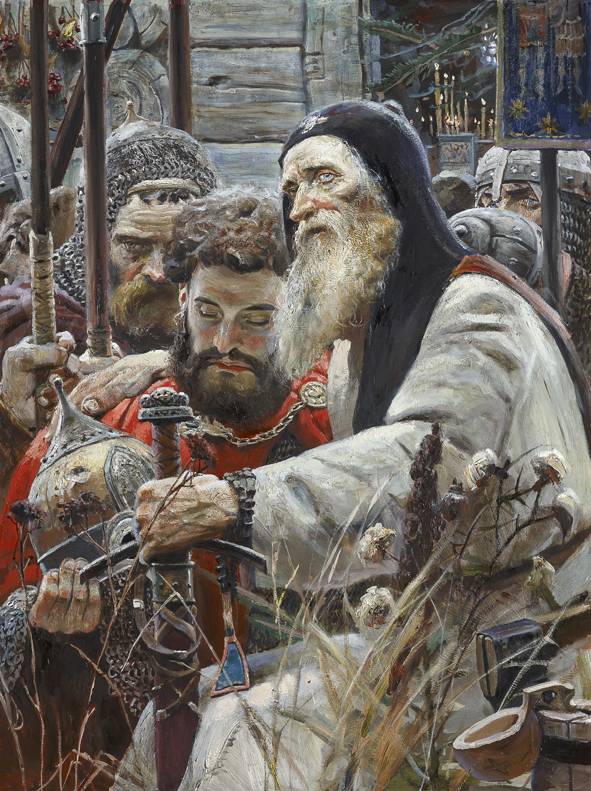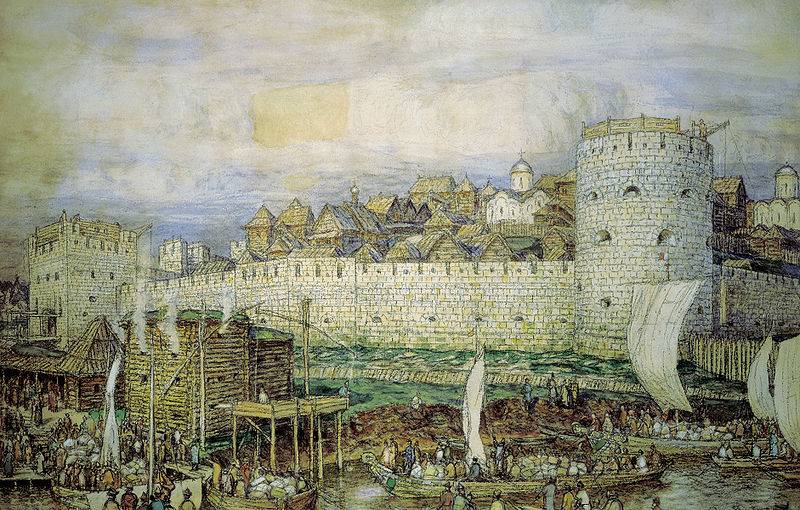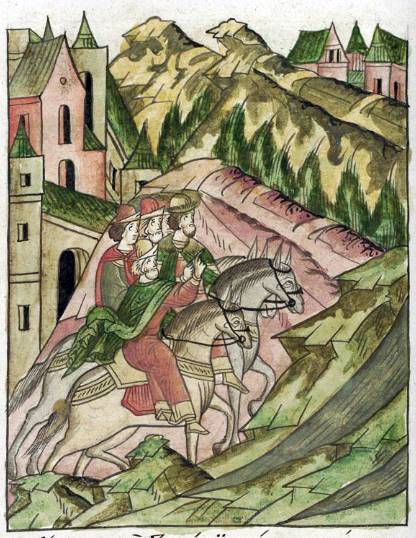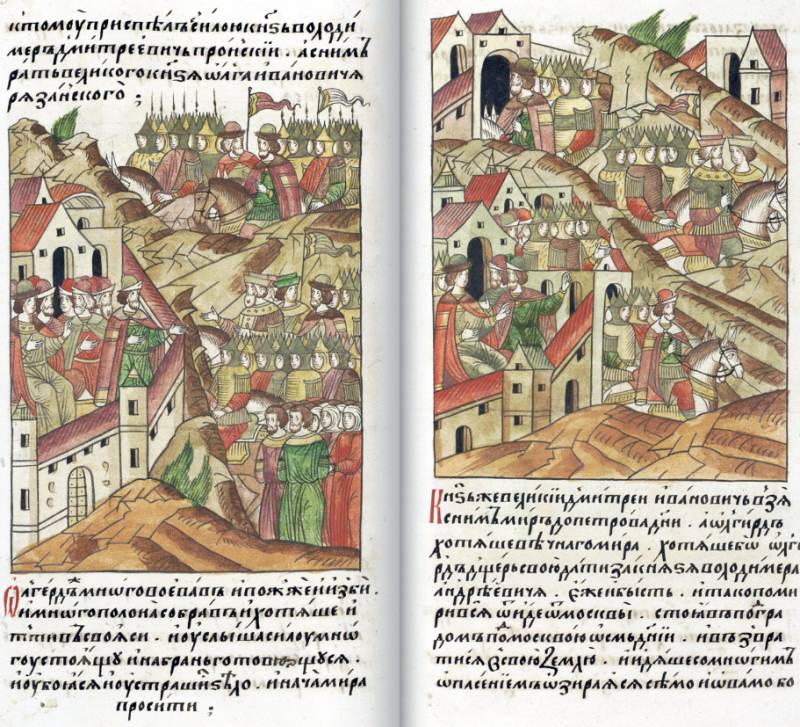Dmitry Ivanovich, prince-warrior. War between Moscow and Tver

670 years ago, the Grand Duke of Moscow and Vladimir Dmitry Ivanovich Donskoy was born. The collector of the Russian lands, the pacifier of Tver, the winner of the Mamai Horde and the creator of the white-stone Moscow Kremlin.
Muscovite Rus in the era of Dmitry Ivanovich waged difficult wars with the Horde and the Grand Duchy of Lithuania and Russia (a pretender to the unification of Russian lands). The Russian lands were subjected to constant invasions, destruction, suffered from internal strife, pestilence and hunger. However, Russia survived and became even stronger. The foundations were laid for the creation of a unified Russian state.
Early years. Struggle for a label to a great reign
Prince Dmitry was born on October 12, 1350 in the family of the Zvenigorod appanage prince Ivan Ivanovich Krasny and his wife Alexandra Ivanovna. The Zvenigorod prince was the son of Ivan Kalita. The supreme power in Muscovite Rus belonged to Kalita's eldest son, Semyon (Simeon) Proud, he had two sons-heirs. According to the then dynastic tradition, they were heirs. Dmitry Ivanovich was to receive only Zvenigorod. However, during these years the "black death" (plague) came to Russia from the East. First, she devastated the lands of Novgorod and Pskov, then came to Moscow. The epidemic spared neither the strong and noble, nor the poor and weak. In March 1353, Metropolitan Theognost died, followed by the sons of the Moscow prince Semyon. In April, the Grand Duke himself died, then the Serpukhov appanage prince Andrei Ivanovich (son of Ivan Kalita).
Ivan Zvenigorodsky remained the only adult man in the dynasty. Ivan Krasny took over the Moscow table (ruled until 1359). He received from the Horde king Janibek a label for the great reign of Vladimir. Moscow at this time had to wage a hard struggle with Lithuania, to resist Ryazan and Nizhny Novgorod. The Nizhny Novgorod-Suzdal prince Dmitry Konstantinovich claimed the grand-ducal title.
Knyazhich Dmitry was brought up traditional for that time: Orthodox education was accompanied by military training. His father Ivan Ivanovich did not rule for long, he died on November 13, 1359. Dmitry was only 9 years old. Ivan Krasny bequeathed his possessions to his two sons, Dmitry and Ivan. Ivan Small received Zvenigorod, but soon died during another pestilence (1364). All possessions were united under the rule of Dmitry. He was lucky with the closest circle: the educator, the Moscow thousand Vasily Velyaminov and the Metropolitan Alexy. They did everything to keep the possession of Moscow.
In 1360, the Moscow embassy, headed by Dmitry himself, went to the capital of the Horde, Saray, to get a shortcut for the Vladimir grand-ducal table (Vladimir was then considered the capital of Russia). In the Horde at this time the so-called. great blush. Tsar Janibek in 1357 was killed by supporters of his son Berdibek. The new khan also massacred all his brothers. Two and a half years later, Berdibek was killed in a new coup. The Horde troubles began. Some khans "ruled" for no more than a month. During this period, the Horde fell apart into several independent states (uluses-appanages). Khan Nouruz gave the label for the great reign to Prince Andrey Dmitrievich of Nizhny Novgorod. He passed it on to his brother Dmitry (Thomas) Suzdal. So the Vladimir table floated out of the hands of the clan of Ivan Kalita. In 1361, a Moscow delegation with Prince Dmitry tried to return the rights to Vladimir, but without success. All this was accompanied by large spending, expensive gifts, bribery of the right people.
In 1362, Moscow was still able to return the grand ducal table. The Moscow army drove out of Pereyaslavl and Vladimir the squad of Dmitry Suzdalsky. Subsequently, he became an ally of Dmitry. Moscow helped the Suzdal prince get the rights to the rich Nizhny Novgorod. After the death in 1365 of the eldest of the Konstantinovichs, the Grand Duke of Nizhny Novgorod-Suzdal Andrei Konstantinovich, the princely table was occupied not by "seniority" by the warlike prince Gorodetsky Boris, the younger brother of Dmitry Suzdal. Moscow gave Dmitry an army and he returned Nizhny Novgorod. The military-political union of Moscow and Nizhny Novgorod was sealed by marriage. In 1366, Dmitry Nizhegorodsky gave his daughter Evdokia to his wife Dmitry Ivanovich. After that, the Grand Duke of Suzdal-Nizhny Novgorod became a loyal ally of Moscow, then fought against Bulgaria and the Mamayev Horde.
Stone Kremlin
The young Grand Duke had to rein in Novgorod. Taking advantage of the turmoil in the Horde, the Novgorod merchants who walked along the Volga and Kama, overnight became river robbers-ushkuiniks. In 1366, they organized a whole campaign, the Novgorod ship army marched in the Volga and Kama. Even Nizhniy was robbed. Moscow immediately replied: cut the path from Novgorod to the Dvina land under its control. In this conflict, Tver, Moscow's longtime rival for the primacy in Russia, took the side of Novgorod. In 1367 Veliky Novgorod yielded, made an apology and gifts. The Novgorodians received the governors of the Grand Duke.
In 1365, a large fire destroyed a significant part of Moscow. The oak Kremlin built by Ivan Kalita was also damaged. Dmitry Ivanovich makes a strategic decision: to build a new wall, not wood, but stone. The construction was completed in record time: 1366-1367. The Russian historian Ivan Zabelin assumed that the material for the construction came from the quarries of the village of Myachkova at the confluence of the Pakhra into the Moscow River. The stone was delivered to the city by the Moscow River. In the summer he was taken by boat, and in the winter by sleigh along the frozen river. The new Kremlin in terms of territory and size was slightly inferior to the modern one. The construction required huge funds. Helped by his cousin Vladimir Andreevich Serpukhovsky (he became Dmitry's closest associate) and the capital's boyars. Some towers and gates were named after them: Sviblova, Sobakina, Cheshkovy, Timofeevskaya.
The significance of the new Kremlin was enormous. It was the only stone fortress in the north-east of Russia. The Grand Duke received a powerful base to fight rivals, to repel enemies. Soon the walls of the new Kremlin helped Dmitry Ivanovich to withstand the army of the Grand Duke of Lithuania Olgerd. He was then able to challenge the Horde. The white-stone Kremlin becomes a symbol of the power of the Moscow princes.

Fight against Tver and Lithuania
During the same period, Moscow was concerned about the rise of Mikhail Alexandrovich Tverskoy. This was a strong and stubborn opponent. In 1366, he was able to get his hands on most of the lands of the Tver Grand Duchy. He was supported by the Grand Duke of Lithuania Olgerd, who was married to the sister of the Tver prince. Grand Duke Dmitry supported his opponents, in particular, Prince Vasily of Kashin. In the Tver land, strife began because of the inheritance of the Klin prince, Dmitry of Moscow sided with Mikhail's opponents. The case ended with the capture of Tver and its plundering. Mikhail fled to Lithuania.
Thus, a long and bloody conflict began. In October 1367, the Tver prince returned from the Grand Duchy of Lithuania with an army and restored his power. Dmitry and his boyars in 1368 invited Mikhail to Moscow for negotiations, promised immunity and arrested the guest. But, fearing the Horde and under the influence of Metropolitan Alexy Mikhail, they let him go, concluding a peace beneficial to Moscow. Vasily Kashinsky died in the same year. Under the pretext of protecting the rights of his heir Mikhail, Dmitry again went to war against Tver. Once again Mikhail Tverskoy flees to Lithuania. Olgerd, not wanting to strengthen Moscow, decides to help the ruler of Tver. In the fall of 1368, the united army of Lithuania, Tver and Smolensk marched against Moscow. In November 1368, on the Trosna River, the allies defeated the hastily assembled Moscow army. Dmitry did not have more troops at hand, and the enemy went to Moscow. Dmitry was saved by the stone Kremlin. Olgerd stood at the Kremlin for three days, but did not dare to siege. After capturing a large full and booty, he left for Lithuania. Dmitry Ivanovich was forced to return the Klin principality to Mikhail Tverskoy. Mikhail is building a new fortress in Tver.
Taking advantage of the fact that Olgerd was at war with the Teutonic Order in 1369, Dmitry moved his regiments to Smolensk. His governors attacked Bryansk, captured Kaluga and Mtsensk. Mikhail Tverskoy tried to negotiate with Dmitry, but without success. The prince of Tver again flees to Lithuania. The Moscow army took the city of Zubtsov by storm, the patrimony of Prince Mikhail Alexandrovich. Moscow troops fought the Tver volosts, ravaged and burned villages, took people to the full. The withdrawal of people at that time was a common occurrence during the war. They were settled in their own lands. Populated and economically developed land (agriculture, crafts in cities) had an advantage over competitors.
In December 1370, Olgerd with his brother Keistut, Mikhail Tverskoy and Svyatoslav Smolensky again went to Moscow. The Grand Duke of Lithuania again besieged Moscow and again could not take it. The Lithuanians retreated, learning that enemy regiments were gathering around them. In 1371, Mikhail Tverskoy went to the Horde, where the powerful nobleman Mamai and his tame khan Mohammed-Bulak already ruled. For great gifts and promises of great tribute, Mamai gave the label for the great reign of Vladimir to the prince of Tver. Mikhail went to occupy the Vladimir table with the tsarist ambassador Sary-Khadzha. However, the Moscow prince simply did not allow Mikhail and the khan's envoy to Vladimir. Mikhail had to flee to Lithuania again. And the khan's envoy was bribed and released into the Horde.
Dmitry of Moscow was not yet ready to quarrel with the Horde. In the summer of 1371, the Grand Duke of Moscow and Vladimir went to Sarai. For ten years the Moscow princes did not visit Sarai and, apparently, did not pay the established tribute. There was great confusion in the Horde. Dmitry brought rich gifts to Mamai, and the powerful ruler gave his dear guest a label for the great reign of Vladimir. Dmitry also entered into an agreement with Mamai, according to which the tribute was set lower than under the kings of Uzbek and Dzhanibek, and bought out the Tver prince Ivan Mikhailovich who was in the Horde for 10 thousand rubles (he lived in Moscow until his father bought him out).
The struggle between Moscow and Tver continued. Cities and villages were burning, blood was pouring. Mikhail Tverskoy again convinces Olgerd to move troops to Moscow Russia. In 1372, Mikhail, together with Keistut and Andrei Olgerdovich, unsuccessfully went to Pereslavl-Zalessky, took Dmitrov and Torzhok. Olgerd moved his regiments to Moscow for the third time. But this time the Moscow army met him on the western border. The matter did not come to a battle, the parties made peace. Vladimir Serpukhovskoy married Elena Olgerdovna.
Storming Tver
In the summer of 1363, Mamai's troops made a campaign against Ryazan. The Ryazan people fought bravely, but could not repel the blow. The Ryazan region was devastated. Perhaps the Horde were going to go further, but Dmitry Moskovsky and Vladimir Serpukhovsky gathered their regiments and settled on the left bank of the Oka. The Horde people were not allowed into the Vladimir and Moscow lands, but they did not help the beaten Ryazan people. Mamaev's temniks did not dare to go further and returned to the steppe.
At the beginning of 1374, Moscow and Tver signed an armistice. Mikhail Tverskoy bought out his son and ceded some lands to Moscow. Then Mikhail received the son of the last thousand-strong Moscow Vasily Velyaminov Ivan, who had fled from Moscow, and sought to inherit the post of a thousand. Dmitry, however, strengthening the grand ducal power, abolished this position. The Tver prince received a label on the Vladimir table from Mamai (who had quarreled with Moscow). The Tver prince sent his troops to Torzhok and Uglich in order to plant his governors there. Dmitry Ivanovich acted quickly: he gathered in Volokolamsk regiments from all of North-Eastern Russia, including troops from Veliky Novgorod, Smolensk and Bryansk (previously they depended on the Grand Duchy of Lithuania). In August 1375, the united Russian army took Mikhail's family nest, Mikulin, and laid siege to Tver.
The siege lasted a month. Tver was protected by a wooden wall, outside it was coated with clay so that it was difficult to set fire to it. The Moscow prince ordered to build two bridges across the Volga and ferried some of the regiments to the other side. Having built a wooden sign (filling up and breaking the ditches) and rounds (siege towers), the regiments of the Grand Duke went on an attack on August 8. Tverichi fought furiously. They made a desperate sortie led by their prince. They were able to destroy the tours, hacked the siege engines. Obviously, the Moscow army was not ready for such a strong attack and suffered heavy losses. Then the city was fenced off with a tynom. It was impossible to break through this palisade either to or from the hail. Hunger began in Tver. At the same time, the troops of the Grand Duke ravaged the Tver land, took Zubtsov and Bely Gorodok.
Olgerd's troops moved east, but did not reach Tver. The Lithuanians limited themselves to the ruin of the Smolensk region, punishing the Smolensk prince for going over to the side of Moscow. When the hope for Lithuania's help collapsed, Mikhail asked for peace. Peace was signed in early September 1375. Mikhail Tverskoy renounced his rights to Kashin, recognized himself as the younger brother of Dmitry of Moscow (vassal). Allied against the Horde:

To be continued ...

Information